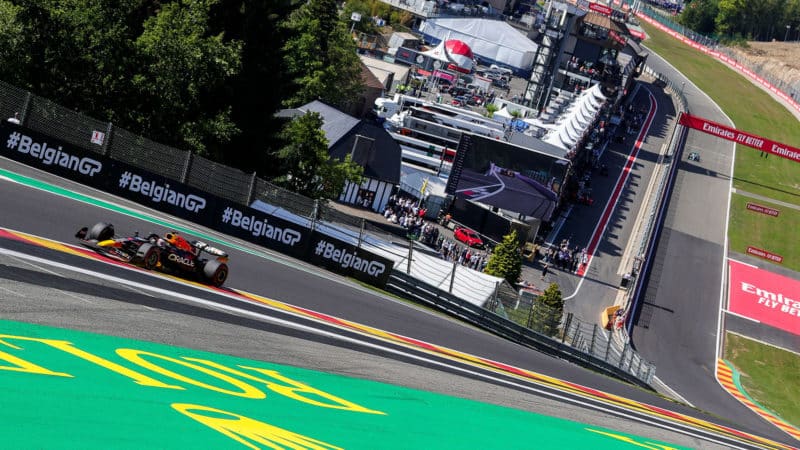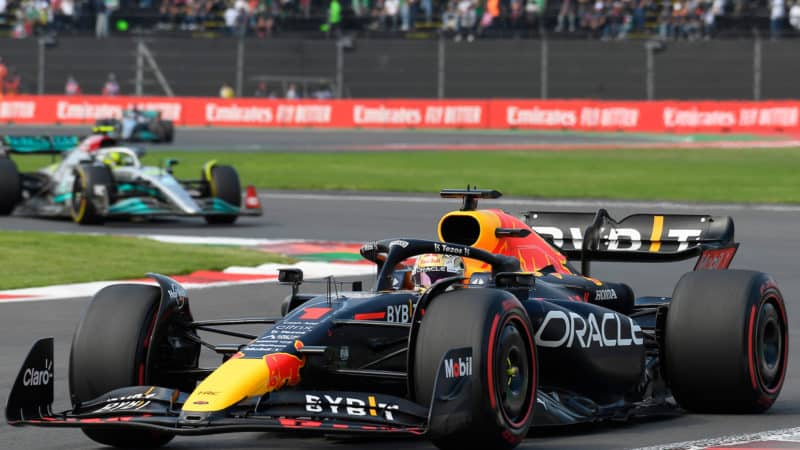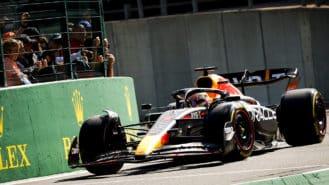Here are the numbers from Mexico stint 1.
• Verstappen qualified on pole with a 1min 17.775sec, new tyres, near-empty tanks, power unit in full deploy.
• By lap two of the race he has, let’s say, 98.6kg of fuel on board. Around here that will cost a calculated 2.76sec of lap time.
• He is on tyres which have done three attack laps, with a calculated degradation rate of 0.0667sec per lap. So costing him a further 0.2sec of lap time.
• His power unit now needs to be in an equilibrium state between harvest and deployment to keep the battery charged. That comes at a cost of around 0.3sec.
So that 1m 17.775sec of qualifying (if he was pushing to the same extent in the race and assuming similar track conditions) would now be 1min 21.036sec. But if he did that he’d quickly have no brakes. Or no tyres. Or both. So, driving to the temperature of his brakes in this case, he actually laps at 1min 23.247sec. So he is driving 2.211sec slower than he is personally capable of doing. Hamilton behind him is doing much the same. We can look at his whole stint like this.
Verstappen Race stint 1 Mexico
qualifying 1m 17.775sec
| Lap | Fuel pen. | Tyre pen. | PU pen. | Theoretical | Actual | Managing | |||
| L2 | Q time + 2.7610s | + | 0.200sec | + | 0.3sec | = | 1min 21.036sec | 1min 23.247sec | 2.211sec |
| L3 | 2.7216sec | + | 0.267sec | + | 0.3sec | = | 1min 21.063sec | 1min 23.079sec | 2.016sec |
| L4 | 2.6824sec | + | 0.335sec | + | 0.3sec | = | 1min 21.092sec | 1min 23.566sec | 2.474sec |
| L5 | 2.6432sec | + | 0.402sec | + | 0.3sec | = | 1min 21.120sec | 1min 23.226sec | 2.106sec |
| L6 | 2.6040sec | + | 0.469sec | + | 0.3sec | = | 1min 21.148sec | 1min 23.294sec | 2.146sec |
| L7 | 2.5648sec | + | 0.536sec | + | 0.3sec | = | 1min 21.176sec | 1min 23.115sec | 1.939sec |
| L8 | 2.5256sec | + | 0.603sec | + | 0.3sec | = | 1min 21.204sec | 1min 23.292sec | 2.088sec |
| L9 | 2.4864sec | + | 0.670sec | + | 0.3sec | = | 1min 21.231sec | 1min 23.246sec | 2.015sec |
| L10 | 2.4472sec | + | 0.737sec | + | 0.3sec | = | 1min 21.259sec | 1min 23.257sec | 1.998sec |
| L11 | 2.4080sec | + | 0.804sec | + | 0.3sec | = | 1min 21.287sec | 1min 23.164sec | 1.877sec |
| L12 | 2.3688sec | + | 0.871sec | + | 0.3sec | = | 1min 21.315sec | 1min 23.076sec | 1.761sec |
| L13 | 2.3296sec | + | 0.938sec | + | 0.3sec | = | 1min 21.343sec | 1min 23.109sec | 1.766sec |
| L14 | 2.2904sec | + | 1.005sec | + | 0.3sec | = | 1min 21.370sec | 1min 23.056sec | 1.686sec |
| L15 | 2.5120sec | + | 1.072sec | + | 0.3sec | = | 1min 21.398sec | 1min 22.971sec | 1.573sec |
| L16 | 2.2120sec | + | 1.139sec | + | 0.3sec | = | 1min 21.426sec | 1min 23.076sec | 1.650sec |
| L17 | 2.1728sec | + | 1.206sec | + | 0.3sec | = | 1min 21.454sec | 1min 23.161sec | 1.707sec |
| L18 | 2.1336sec | + | 1.273sec | + | 0.3sec | = | 1min 21.482sec | 1min 23.288sec | 1.806sec |
| L19 | 2.0944sec | + | 1.340sec | + | 0.3sec | = | 1min 21.509sec | 1min 23.432sec | 1.923sec |
| L20 | 2.0552sec | + | 1.407sec | + | 0.3sec | = | 1min 21.537sec | 1min 23.674sec | 2.137sec |
| L21 | 2.0160sec | + | 1.474sec | + | 0.3sec | = | 1min 21.655sec | 1min 23.295sec | 1.640sec |
| L22 | 1.9768sec | + | 1.541sec | + | 0.3sec | = | 1min 21.592sec | 1min 23.597sec | 2.004sec |
| L23 | 1.9376sec | + | 1.608sec | + | 0.3sec | = | 1min 21.621sec | 1min 23.655sec | 2.034sec |
| L24 | 1.8984sec | + | 1.675sec | + | 0.3sec | = | 1min 21.648sec | 1min 23.861sec | 2.213sec |
We can see that the closest Verstappen ever gets to his theoretical potential pace is on lap 15 at just under 1.6sec off what he could do if he wasn’t having to manage brakes/tyres etc. He is lapping throughout the stint at between 1.6sec and 2.2sec of what he could physically do – from the perspective of driving ability. The consistency is indeed impressive, but it is ‘just’ a consistency in matching his brake temperatures, tyre temperatures and power unit usage while trying to eke out the necessary gap over Hamilton so as not to be under threat around the pit stops. It’s a great skill, but it’s not the differentiator between a great driver and a good one in the way that nailing the same lap time when absolutely on the physical limit in the sprint era of F1 was, when you had just enough fuel in the tank for that stint and tyre war rubber which didn’t wildly overheat when you pushed on. Then, the fastest way to complete a race was by driving flat-out and hence the consistency of super-fast times was an awesome achievement. Nowadays, it does not signify what it used to.
Could Verstappen achieve that level of consistency in the ‘sprint’ era of F1? Of course he could – because he is a truly incredible driver. But forget ‘consistency’ being the proof of this. They can all ‘manage’ a race stint.



